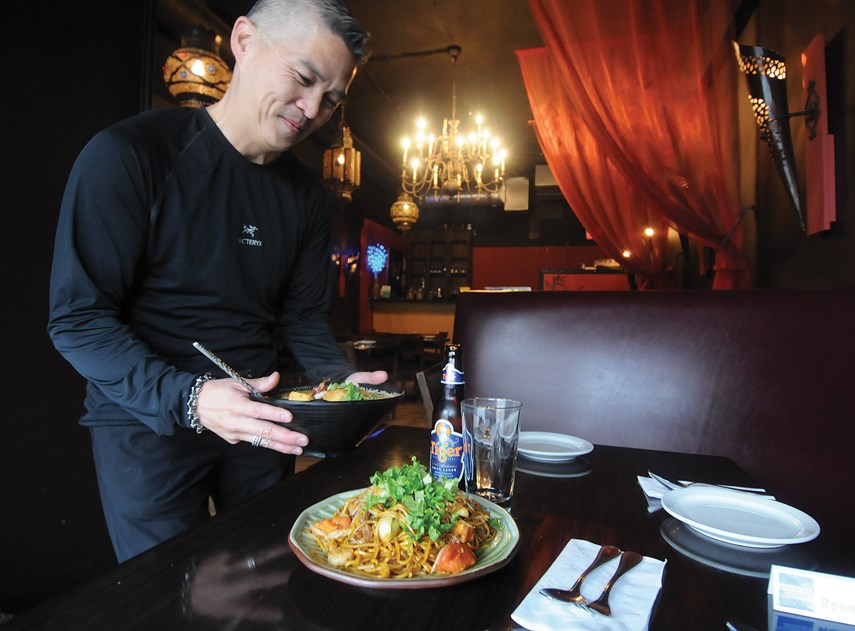This was to be a story about noodles. Malaysian noodles, specifically, a departure from my last review of Tamarind Hill, several years ago, in which I focussed on Laksa, a national signature dish.
I wanted to contrast the experience of sitting amidst the dark wood and moody lighting of Tamarind’s space with a quick and casual take-out experience, painting a picture of a menu for all occasions. But as I sat in the restaurant briefly awaiting my take out order, I engaged with the staff about the Vancouver Canucks, recounting my disappointment in the outcome of the 1982 season in which our team succumbed to the New York Islanders and my stacks of hockey cards suddenly became to me, at the time, little more than dog-eared scraps of bubblegum-scented cardboard.
We talked briefly about the Sedins as well, and about the future of the franchise. As we talked about the Swedish twins in the Malaysian restaurant, I thought about how one of the dishes in my order was Indian Mee Goreng. And then about how just down the road is one of the best Indian restaurants in the city, Palki. Or how the Taiwanese bubble tea and waffle joint a block away, Zestea, serves the tastiest frozen watermelon drink you can find.
My mind wandered to the strip of Lonsdale between 23rd Street and 13th Street, along with all the arteries on the way, that is home to the most authentic Persian foods and ingredients outside of Iran. There is Thai food to be had almost across the street at Krua Thai, there are more sushi restaurants in the neighbourhood than I could list in a single column, Puccini’s Deli curates top shelf Italian goods, Kostas cooks up great Greek food, and there are, to wit, three Pho joints in a four block span in the same vicinity.
It occurred to me that Tamarind Hill is a perfect symbol of our community’s diversity. Malaysian cuisine as we understand it today comes from numerous influences, each weighing in with unique flavours, textures, techniques, and traditions that conspire to make an extraordinarily rich and complex cuisine that is greater than the sum of it parts. Those influences include the indigenous people of Malaysia’s sprawling geography, people of Austronesian heritage who comprise what is known as Malay, Chinese, and Indian influences, as well as British, Persian, and Arabic, not to mention tangential influences from bordering neighbours like Thailand, Vietnam, Singapore, Philippines, Indonesia, and Brunei. By the time I paid for my order, I felt like there was considerable weight to my takeout bag, a cultural gravity far beyond the mere physical contents.
Now, back to those noodles. Goreng refers to fried foods in Malay, so Nasi Goreng is fried rice, while Mee Goreng, which is what I ordered, is fried noodles, most commonly yellowish, flat, wheat-based noodles. The dish was only $11, a seemingly trifling price for a generous serving of what turned out to be a truly fantastic noodle stir-fry. A mountain of dense, stretchy egg noodles were pan-fried over high heat (I know this because of the tasty, tell-tale sear on the noodles) along with tender lean strips of marinated beef, a handful of sizeable prawns, scrambled egg, tofu, and vegetables including tomato, bean sprouts, and onions. In the complex and aromatic sauce in which all of these ingredients were cooked, I detected the garlicky, citrusy, chilli-laden kick of sambal, as well as soy sauce and something with a subtle and balanced hint of sweetness, likely palm sugar. The dish is popular street hawker fare in both Malaysia and Singapore, where it is also known as Mee Goreng Mamak. Mamak is a Tamil colloquialism for ‘uncle’, a term used by children to refer to adult men. I ate the dish directly from the container with a pair of chopsticks and an IPA from Victoria’s Driftwood Brewery, sitting on my front steps on an unseasonably mild November evening, perhaps trying to approximate the experience of a meal picked up from a food stall.
An order of Sambal Black Tiger Prawns proved to be nearly as satisfying as the noodles, the hefty prawns fully coated in a brick-hued, aromatic paste resulting from stir frying with sun dried chilli, garlic, lemongrass, shrimp paste, and dried shrimp. The prawns were accompanied by green and red peppers and scallions. I treated the dish as finger food, grabbing prawns by the crispy tail along with a stalk of fried scallion; great stuff, especially with a super cold beer.
Deep fried calamari with spicy dipping sauce was pretty basic and unremarkable, perhaps the more so for having followed the two bold, flavour-forward dishes described above, though the sauce had an admirable heat level.
Though it is an odd pairing for noodles, Roti Canai remains one of my favourite dishes and rounded out my menu sampling. Tamarind Hill does an excellent job in realizing these flaky, chewy, pan-fried bread treats and the accompanying coconut milk-scented, spicy curry dipping sauce is an explosion of big flavours. I would suggest roti canai is a smart thing to order as you browse the rest of the menu, the dish offering a unique take on the basket of bread so often presented before ordering in many restaurants.
My meal of four dishes was $47 before gratuity.
Tamarind Hill, 1440 Lonsdale Avenue. Tamarindhill.ca. 604-990-0111.



